Investing in the American Dream
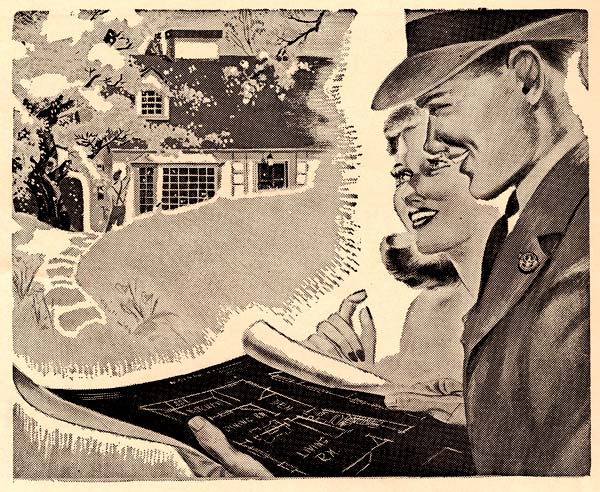 A veteran and his wife look at plans and dream about their future in their new home financed by a G.I. Bill loan. (Folder 19, Box 37, Defense Council Records, OSA)
Enlarge image
A veteran and his wife look at plans and dream about their future in their new home financed by a G.I. Bill loan. (Folder 19, Box 37, Defense Council Records, OSA)
Enlarge image Although governments and organizations across the country offered services to World War II veterans, none compared in scope and impact with the G.I. Bill of Rights. Officially known as the Servicemen's Readjustment Act of 1944, the G.I. Bill addressed fears about millions of veterans returning home without jobs and susceptible to radical political ideas and social unrest. Looking ahead to the postwar period, President Roosevelt said in 1943: "Veterans must not be demobilized into an environment of inflation and unemployment, to a place on a bread line or on a corner selling apples. We must this time have plans ready." The resulting act offered over 15 million veterans of World War II substantial benefits, including free education, job training, mortgage loans, small-business loans, and unemployment insurance.
Footnote
1 Legislative Efforts
While nearly everyone agreed something had to be done to assist returning veterans, differences arose in the debate over the type and amount of aid to be offered. In the beginning many lawmakers and educators worried the bill would cost too much, lower educational standards, or encourage laziness on the part of veterans. But these reservations were overwhelmed by dire predictions of unemployment and civil unrest if substantial legislation were not passed. And, telling Congress that America was "morally obligated" to prevent veterans from suffering economic hardships, Roosevelt echoed the findings of a White House study recommending a series of education and training programs. The American Legion played a leading role in designing legislation and convincing Congress to pass it. After completing a first draft of the G.I. Bill in early 1944, American Legion members defended the program against critics who worried that the legislation was too sweeping and could backfire. Legion members organized a grassroots campaign to flood congressmen and senators with letters of support. The effort paid off. The bill overwhelmingly passed both houses and was signed by Roosevelt on June 22, 1944.
Footnote
2
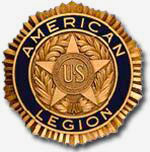 The American Legion played a key role in pushing the G.I. Bill through Congress.
The American Legion played a key role in pushing the G.I. Bill through Congress. Well before Congress passed the G.I. Bill, Oregon leaders were making plans of their own to assist veterans. The 1943 Legislature created the War Veterans Service Committee to "take the lead in our state in rendering service to our veterans...." The committee included representatives of the American Legion and Veterans of Foreign Wars and was managed by a veteran of World War II, who soon set up an office in Portland. The success of the operation in the Portland area prompted the Legislature to expand the program in 1945. Replacing the War Veterans Service Committee, the new Department of Veterans' Affairs was charged with the "organization and coordination of the administration of all laws, federal and state, pertaining to the 147,000 war veterans and their dependents in this state." Meanwhile, the 1943 Legislature passed House Bill 400 to provide educational aid to the returning veterans. The measure was referred to voters and easily approved the next year.
Footnote
3 Educational Aid
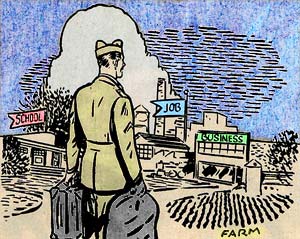 Returning veterans could choose from school, job, business, and farm assistance from the G.I. Bill. (Folder 13, Box 36, Defense Council Records, OSA)
Returning veterans could choose from school, job, business, and farm assistance from the G.I. Bill. (Folder 13, Box 36, Defense Council Records, OSA) Oregon's World War II veterans could choose between accepting educational aid from the federal G.I. Bill or from the state's own program. The G.I. Bill was offered to those had served 90 days or more after Sept. 16, 1940 and had received other than a dishonorable discharge. Veterans were entitled to one year of full-time training plus a period equal to their service time--up to a maximum of four years--to be used at any approved educational or training facility in the country. By contrast the state plan was limited to those who were residents of Oregon for at least a year prior to entering the service. An applicant for state aid needed to have served 90 days in the military and the Oregon program was not available to anyone receiving G.I. Bill educational assistance. Moreover, the state plan required that the money be used at schools in Oregon.
Footnote
4
The aid programs offered different amounts of educational aid as well. The G.I. Bill would pay up to $500 per school year for tuition and fees. For reference, costs even at expensive universities rarely exceeded $300 per year at the time. The money could be applied to books, supplies, and other expenses "as are generally required for the successful pursuit and completion of the course by other students in the institution." However, the money was not to be used for "board, lodging, other living expenses and travel." Instead, veterans could apply for subsistence payments amounting to $50 per month or $75 per month with dependents. Both amounts were raised in 1946 and again in 1948. The state's financial aid package was more modest. A student could receive $75 for the first month of school and $50 for each month for eight months thereafter. The amount dropped to $35 per month for nine months during each of the next three years. Not surprisingly, most Oregon veterans chose the G.I. Bill. However, for those with little over 90 days of service, the state plan could pencil out since it would still pay for four years of school, whereas the G.I. Bill would only pay for one year. This advantage attracted over 700 veterans to apply and gain approval of state educational aid in a nine month period in 1946.
Footnote
5Colleges and Schools Respond
Regardless of whether they chose the federal or state educational aid, veterans took advantage of the opportunity in numbers that few officials predicted. Before the World War II era G.I. Bill program ended, 7,800,000 veterans out of a total population of 15,440,000 were trained. These totals included 2,230,000 in college; 3.480,000 in other schools; 1,400,000 in on-the-job training; and 690,000 in farm training. The total cost of the World War II educational program came to 14.5 billion dollars. The flood of new students brought big changes on college campuses in the late 1940s and early 1950s. During the G.I. Bill peak attendance year of 1947, veterans made up just under half of all college enrollment nationwide in a phenomenon that came to be known as the "G.I. Bulge." Universities across the country ballooned in size. For instance, the University of Michigan grew from under 10,000 students before the war to over 30,000 students in 1948. Syracuse University grew from about 6,000 before the war to 19,000 in 1947.
Footnote
6
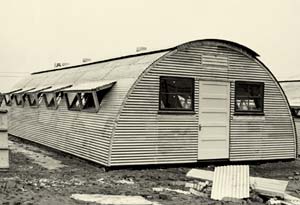 Quonset huts became a fixture on college campuses across the country as G.I. Bill students flooded in after the war. (Image courtesy msu.edu)
Quonset huts became a fixture on college campuses across the country as G.I. Bill students flooded in after the war. (Image courtesy msu.edu) Oregon colleges saw impressive bumps in student population as temporary buildings sprang up on and around campuses to provide classroom and housing facilities. Many campuses devised creative responses to the challenge that combined the use of prefabricated housing, Quonset huts, and trailers. John Lienhard, then a G.I. Bill student at Oregon State College (now University) remembered how "they threw up tacky prefab quarters in their mud flats--squalid quonset-hut housing for married students." Meanwhile, the University of Oregon created the large Amazon and Columbia student housing projects in 1947 from Portland area shipyard housing that was shipped and reconstructed in Eugene not far from the campus.
Footnote
7 Barbara Gunn, whose husband studied at the University of Oregon on the G.I. Bill in the late 1940s, described the college life for many young families: "College has been anything but a shelter from real life--it's been a baby crib squeezed into one corner, diapers drying over the furnace, and grocery bills instead of prom tickets."
Footnote
8
The Legislature responded by turning normal (teacher training) schools in La Grande, Ashland, and Monmouth into liberal arts colleges to meet the demand. Portland area veterans flocked to the Vanport Extension Center and the Portland Extension Center of the State System of Higher Education, which later merged and became Portland State University.
Educators expressed a consensus that veterans were the best students ever seen on college campuses. The education editor of the
New York Times noted in late 1947 that "the G.I.’s are hogging the honor rolls and the Dean's lists." None of the nearly 8,000 veterans studying at Columbia University in 1947 was in "serious academic difficulty" and even the president of Harvard University admitted that "for seriousness, perceptiveness, steadiness, and all other undergraduate virtues," the veterans were "the best in Harvard's history." One observer captured the difference between the G.I. Bill students and the regular students across the country, writing that "lights stay on late at night in many rooms. The quietness of the dormitories is enough to sober the most chronic of noise-makers. The library is filled with diligent seekers of knowledge. Little interest in anything but studies has been exhibited. The veteran realizes he has a golden opportunity and a well-earned one and he is out to make the most of it." But the solid work ethic caused friction too. One non-veteran Lehigh University student probably betrayed the resentment of many other students when he complained, "veterans work so hard, we have to slave to keep up."
Footnote
9 Vocational Education
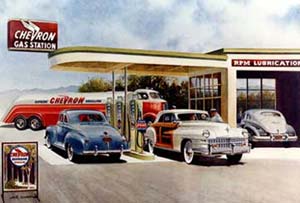 G.I. Bill on-the-job training was offered for veterans who wanted to be service station attendants. (Image courtesy chevron.com)
G.I. Bill on-the-job training was offered for veterans who wanted to be service station attendants. (Image courtesy chevron.com) G.I. Bill educational opportunities included more than traditional four-year colleges and universities. Many veterans opted for on-the-job and apprentice-based vocational training instead. The Oregon Department of Veterans' Affairs distributed bulletins describing the possibilities to those more interested in learning a trade than pursuing an academic education. The G.I. Bill had provisions allowing for wages to be supplemented while veterans learned a vocation or worked as apprentices. These allotments mirrored the dollar amount of subsistence allowances given to academic students. Veterans could choose from dozens of options for on-the-job training, which was classified to include occupations requiring from 1,000 to 4,000 hours of training. Examples included automobile painter, bookkeeper, candy maker, sales clerk, radio announcer and service station attendant. Apprenticeships required from 4,000 to 8,000 hours and included automobile mechanic, carpenter, baker, dental technician and upholsterer among others. Officials noted that "such work as truck driving and parking-lot attendant would not qualify because not enough training time is required to learn the occupation."
Footnote
10
Worried about potential abuse by employee and employer, readers were reminded that the money was "not intended as a 'dole' for the veteran nor as a means whereby the employer gets cheap labor at government expense." In fact, most of the abuses in the G.I. Bill program centered on trade-level training and education. Vocational and business schools sprang up like mushrooms in the first years of the G.I. Bill. Many of them were scams that collected government money and provided no education of any value. Congress eventually tightened the restrictions on vocational and technical schools in 1949.
Footnote
11Other G.I. Bill Financial Aid
Officials noted that "such work as truck driving and parking-lot attendant would not qualify because not enough training time is required to learn the occupation."
In addition to educational aid, both the G.I. Bill and an Oregon government program offered low interest loan guaranties to help veterans readjust to the civilian economy. The eligibility requirements were the same as for the educational financial aid. The loan programs had the objectives to reward veterans for their sacrifices while spurring the economy and providing an investment outlet for the record amounts of savings that existed at the end of the war. Once again, significant differences existed between the federal and Oregon programs. For instance, the G.I. Bill program was more expansive, allowing loans for homes, farms, businesses, equipment, supplies, and other assets. The Oregon program allowed loans only for homes and farms.
Footnote
12
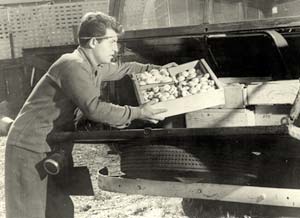 This veteran started a business with the aid of a G.I. Bill loan. (Image no. NY669-R courtesy U.S. Veterans Administration)
This veteran started a business with the aid of a G.I. Bill loan. (Image no. NY669-R courtesy U.S. Veterans Administration) As originally written, the G.I. Bill program administered by the Veterans Administration had significant flaws. The guaranty was limited to 50% of the loan, not to exceed $2,000 with a maximum interest rate of 4%. The purchase or construction cost could not exceed the "reasonable normal value" as determined by an appraisal and all loans initially required the prior approval of the Veterans Administration. Before long the plan's real world shortcomings became apparent. For example, real estate prices had increased so much that the maximum guaranty of $2,000 was not enough to help most veterans. Many interpreted the "reasonable normal value" to mean prewar prices, which limited loan acceptance. Congress fixed these and others problems in a major 1945 revision that doubled the guaranteed amount to $4,000, deleted the word "normal" to reduce appraisal interpretation problems (leaving the words "reasonable value" instead), extended loan periods, and extended the deadline for veterans to apply for loans. Subsequent changes over the years further refined the program. From 1944 to 1952, over 2,360,000 World War II veterans received G.I. Bill loans. The peak year of 1947 total 640,298 loans, including 562,985 home loans, 24,690 farm loans, and 52,623 business loans.
Footnote
13
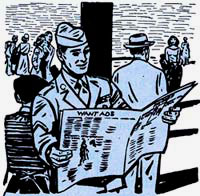 Veterans who were unable to find a job could join the "52-20 Club" and collect G.I. Bill unemployment benefits of $20 a week for up to a year. (Folder 13, Box 36, Defense Council Records, OSA)
Veterans who were unable to find a job could join the "52-20 Club" and collect G.I. Bill unemployment benefits of $20 a week for up to a year. (Folder 13, Box 36, Defense Council Records, OSA) Veterans were entitled to receive other benefits under the G.I. Bill. For instance, they could receive unemployment pay of $20 a week for up to 52 weeks. Despite earlier worries about encouraging slothful behavior, this part of the program caused few problems. Less than 20% of the funds set aside for the so-called "52-20 Club" were actually used. Instead, most veterans were either working or in school. Still, the program did have safeguards to protect against abuse. A veteran could be disqualified "if he leaves suitable work voluntarily, without cause, or for misconduct, if he fails to accept suitable work when offered" or for other related reasons. Self-employed veterans could qualify for payments under certain circumstances. Other G.I. Bill provisions included offering veterans help finding jobs, setting up military review of dishonorable discharges, and giving top priority for building materials to Veterans Administration hospitals.
Footnote
14 Impact of the G.I. Bill
Overall, historians have judged the G.I. Bill to be one of the most successful government programs in history. The short term goals of keeping unemployment and potential social strife in check were met. But the long term impact of the program must have surprised even its ardent supporters, with profound benefits not only for the individual veterans but also the nation. The educational benefits opened up universities and other centers of learning to people who previously would not have dreamed of college. The loan guaranty program provided millions of veterans with the means to realize the "American Dream" of owning their own homes. And at a time when the military was segregated and racial discrimination was the norm, Congress took the enlightened approach of making most benefits available regardless of race, gender, or military rank. Taken as a whole, the G.I. Bill has to be seen as a major contributor to the growth of the middle class in the decades after World War II.
Footnote
15 Related Documents
Notes